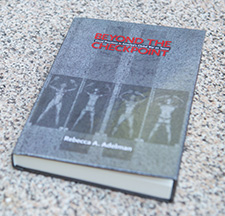Cultures of Conflict
Professor Rebecca Adelman traces connections between citizenship and images of the war on terror.
Flying home from New Orleans to Cleveland in August 2003, Rebecca Adelman encountered a faulty metal detector at a security checkpoint. The alarm blared as she passed through once, then again and again, until several federal agents and police officers guided her to a windowless room where she was questioned for nearly an hour. A security agent finally suggested trying a different detector, and she was deemed a non-threat after passing through the new device without triggering the alarm.
Adelman, now an assistant professor of media and communication studies at UMBC, started graduate school just a few weeks later. Her distressing experience seemed like nothing but an interesting dinner party anecdote at the time, but it stayed on her mind. Years later, it provoked a powerful research question.
I started to think that maybe something more important had happened there, Adelman reflects. Maybe in the moment of me having this encounter with these security technologies and the people who were wielding them, something more important happened to me than just this fluke or mistake. I began to think about the ways that experience changed me as a thinker and citizen.
From this experience, and years of research that followed, emerged Adelmans new book, Beyond the Checkpoint: Visual Practices in Americas Global War on Terror (University of Massachusetts Press 2014). The book provides a comprehensive overview of the visual culture of the Global War on Terror, including imaging technologies like those at security checkpoints. Adelman contends that since the 9/11 terrorist attacks, American citizenship has been redefined by images of the Global War on Terror.
The book tries to rethink how we envision the relationship between state and citizen and image, Adelman observes. I hope it encourages people to think differently about the role of the visual in wartime and to think more critically, comprehensively and creatively about it.
Some Global War on Terror images are familiar to most Americans, including footage of the 9/11 terrorist attacks and the 2003 Shock and Awe campaign in Iraq. However, Adelman argues that by studying images that are frequently overlooked but are part of our everyday experiences, Americans can better understand how they have shaped the countrys thinking as it relates to prosecution of this war domestically and abroad.
When were talking about war and terrorism, were talking about phenomena that cant ever be fully represented because theyre so big and overwhelming. They cant fit in the frame of a single picture or a three-minute news story, so representations are always limited, Adelman says.
Adelmans research traces connections between citizenship and spectatorship, and focuses on institutions that create, monitor and regulate the visual culture of the Global War on Terror. Shes hopeful her work will provide a blueprint for looking beyond common images and thinking more broadly about how visual cultures of conflict will be portrayed in the decades ahead.
We can all understand now that there is an intimate relationship between war and visual media. Its been that way since the Civil War, Adelman says. Its going to continue to evolve, and I hope my book provides a way to think about that evolution.
Adelman discussed her new book as a guest on WYPRs Maryland Morning. You can listen to the complete interview here.
(06/12/2014)

